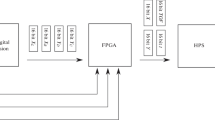Abstract
The signal digitization for CROSS, a bolometric experiment for the search of neutrinoless double beta decay at LSC—Canfranc Underground Laboratory, will be based on a custom solution comprised of an analog-to-digital board interfaced to an Altera Cyclone V FPGA module. Each analog-to-digital board hosts 12 channels that allow data digitization up to 25 ksps per channel and an effective resolution of 21 bits at the typical sample rate required by the experiment (5 ksps). The board also allows to digitally select the cutoff frequency of the anti-aliasing filter with 10 bit resolution from 24 Hz up to 2.5 kHz, as required by fast scintillating bolometers. The FPGA is responsible for the synchronization of the analog-to-digital boards and for the data transfer to the storage, using UDP protocol on a standard Ethernet interface. Each FPGA can manage the data coming from eight boards (96 channels), allowing an excellent scalability. In this contribution, we will present a complete overview of the system and a detailed characterization of the system performance.







Similar content being viewed by others
References
I. C. Bandac et al., The \(0\nu 2\beta \)-decay CROSS experiment: preliminary results and prospects, arXiv:1906.10233 (2019)
C. Alduino, First results from CUORE: a search for Lepton number violation via \({0\nu \beta \beta }\) decay of \({^{130}Te}\). Phys. Rev. Lett. 120, 132501 (2018). https://doi.org/10.1103/PhysRevLett.120.132501
C. Nones et al., Superconducting aluminum layers as pulse shape modifiers: an innovative solution to fight against surface background in neutrinoless double beta decay experiments. J. Low Temp. Phys. 167, 1029–1034 (2012). https://doi.org/10.1007/s10909-012-0558-y
O. Azzolini, First result on the neutrinoless double-\({\beta }\) decay of \({^{82}Se}\) with CUPID-0. Phys. Rev. Lett. 120, 232502 (2018). https://doi.org/10.1103/PhysRevLett.120.232502
Author information
Authors and Affiliations
Corresponding author
Additional information
Publisher's Note
Springer Nature remains neutral with regard to jurisdictional claims in published maps and institutional affiliations.
The project CROSS is funded by the European Research Council (ERC) under the European Union Horizon 2020 Program (H2020/2014-2020) with the ERC Advanced Grant No. 742345(ERC-2016-ADG).
Rights and permissions
About this article
Cite this article
Carniti, P., Gotti, C. & Pessina, G. High-Resolution Digitization System for the CROSS Experiment. J Low Temp Phys 199, 833–839 (2020). https://doi.org/10.1007/s10909-019-02249-9
Received:
Accepted:
Published:
Issue Date:
DOI: https://doi.org/10.1007/s10909-019-02249-9




